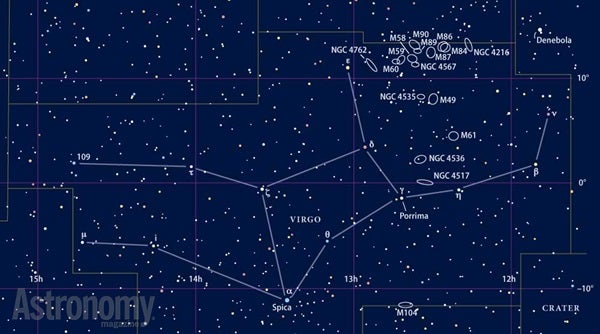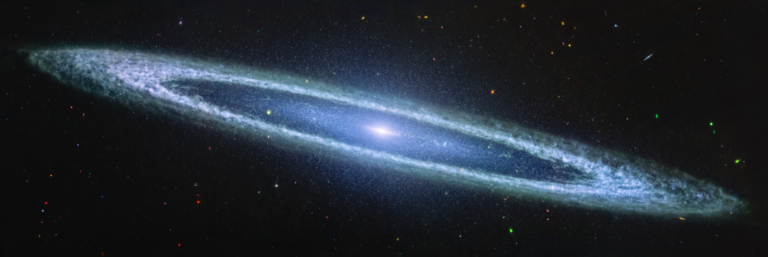Targets for March 12–19, 2015
Small telescope: Spiral galaxy M61
Small telescope: The Silver Needle Galaxy (NGC 4244)
Large telescope: Spiral galaxy NGC 3998
This week’s first small-telescope target is spiral galaxy M61 in Virgo the Maiden. It glows at magnitude 9.7, so you’ll want to view it from as dark a site as you can get your small scope to. The galaxy measures 6.0′ by 5.9′.
To find M61, first locate the stars 16 and 17 Virginis. The former shines at magnitude 5.0, and the latter at magnitude 6.5. M61 lies between these two stars, a tiny bit closer to 17 Virginis.
M61 is a face-on spiral galaxy. However, its arms wind tightly around the core, so this object doesn’t have nearly the detail shown by M101 in Ursa Major. Still, its surface brightness is higher, making it an easier catch through a small scope.
That said, an 11-inch telescope will allow you to see the stubby extensions of two arms. Through really big scopes at high magnification, look for a thick bar that runs north-south through this object.
In his 1844 classic observing guide, Cycle of Celestial Objects, English astronomer William Smyth describes M61 as “a large pale-white nebula between the Virgin’s shoulders. This is a well defined object, but so feeble as to excite surprise that Messier detected it with his 3½-foot telescope in 1779.”
A needle in a cosmic haystack
This week’s second small-scope object is the Silver Needle Galaxy, also known as NGC 4244 and Caldwell 26. This great deep-sky object lies in Canes Venatici the Hunting Dogs. You’ll find it 4.7° southwest of magnitude 4.2 Chara (Beta [β] Canum Venaticorum).
To observers, spring in the Northern Hemisphere means it’s time to hunt galaxies. And while the giant constellations Virgo, Ursa Major, and Leo hold hundreds of worthy targets, don’t overlook Canes Venatici. Although its stars are faint (Canes Venatici is only the 84th brightest constellation), it contains many bright galaxies.
Four of these made Messier’s list — the Whirlpool Galaxy (M51), the Sunflower Galaxy (M63), M94, and M106. And although the Silver Needle Galaxy doesn’t stand out like these luminaries, it has a lot to offer observers. It glows at magnitude 10.4 and measures 17.0′ by 2.2′ — now that’s what I call a needle!
NGC 4244’s disk appears almost edge-on, tilting only 5° to our line of sight. Through the eyepiece, this galaxy has a relatively even illumination — the core appears only slightly brighter than the rest. What sets the Silver Needle Galaxy apart, however, is its length-to-width ratio and its appearance through small telescopes.
Once you view this object through a 4-inch or smaller telescope from a dark site, you’ll understand why its name contains the word “needle.” Through larger scopes, the needle-like quality disappears. To the northeast, the galaxy fades gradually into a broad haze. On the opposite side of the core, the surface appears more mottled and irregular.
The trouble with spirals
This week’s large-telescope target is our third spiral galaxy — NGC 3998 in Ursa Major the Great Bear. This object lies 1.9° north-northeast of magnitude 2.4 Phecda (Gamma [γ] Ursae Majoris). It glows at magnitude 10.6 and measures 2.7′ by 2.3′.
Remember the original Star Trek episode “The Trouble with Tribbles”? When I observe NGC 3998, it reminds me of a Tribble because it’s oval, it has a soft edge, and I get the sense of three-dimensionality from viewing it. Call me crazy.
Another fairly bright galaxy, NGC 3990, sits 3′ west of NGC 3998. Between the two, look for MGC +09–20–046 through a 16-inch or larger telescope. I’ve seen it through a 30-inch scope as a (still) faint oval that I could observe with direct vision.
Expand your observing at Astronomy.com
StarDome
Check out Astronomy.com’s interactive StarDome to see an accurate map of your sky. This tool will help you locate this week’s targets.
The Sky this Week
Get a daily digest of celestial events coming soon to a sky near you.
Observing Talk
After you listen to the podcast and try to find the objects, be sure to share your observing experience with us by leaving a comment at the blog or in the Reader Forums.











